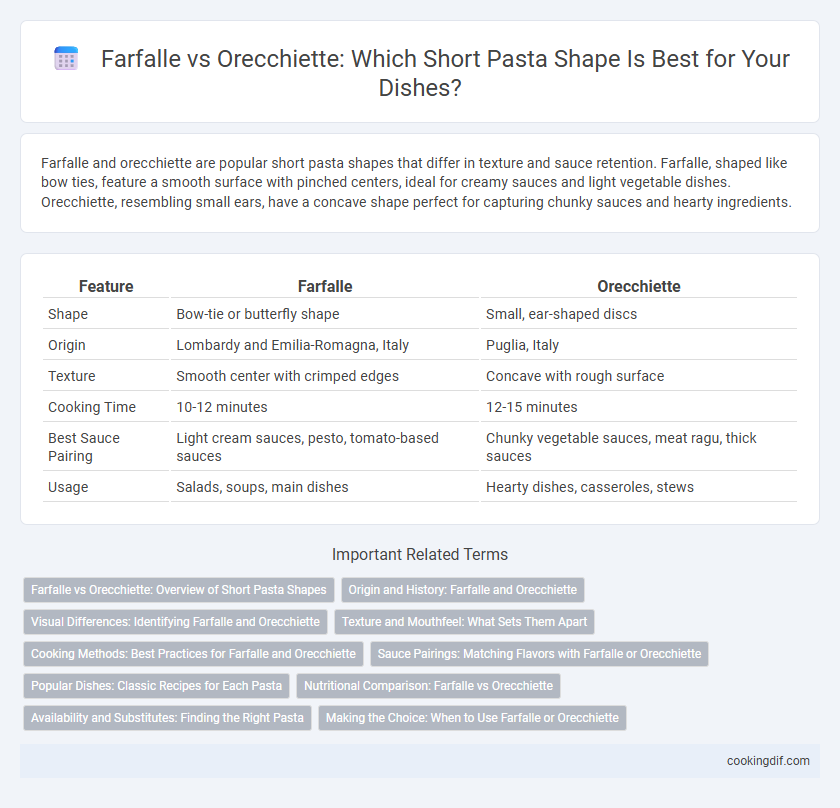Farfalle and orecchiette are popular short pasta shapes that differ in texture and sauce retention. Farfalle, shaped like bow ties, feature a smooth surface with pinched centers, ideal for creamy sauces and light vegetable dishes. Orecchiette, resembling small ears, have a concave shape perfect for capturing chunky sauces and hearty ingredients.
Table of Comparison
| Feature | Farfalle | Orecchiette |
|---|---|---|
| Shape | Bow-tie or butterfly shape | Small, ear-shaped discs |
| Origin | Lombardy and Emilia-Romagna, Italy | Puglia, Italy |
| Texture | Smooth center with crimped edges | Concave with rough surface |
| Cooking Time | 10-12 minutes | 12-15 minutes |
| Best Sauce Pairing | Light cream sauces, pesto, tomato-based sauces | Chunky vegetable sauces, meat ragu, thick sauces |
| Usage | Salads, soups, main dishes | Hearty dishes, casseroles, stews |
Farfalle vs Orecchiette: Overview of Short Pasta Shapes
Farfalle and Orecchiette are distinctive short pasta shapes known for their unique textures and culinary uses. Farfalle, shaped like small butterflies or bow ties, offers a smooth surface ideal for lighter sauces and salads, while Orecchiette, resembling small ears, features a concave shape that holds thicker sauces and chunky vegetables effectively. Both pastas enhance various dishes by providing contrasting textures and sauce retention properties tailored to different recipes.
Origin and History: Farfalle and Orecchiette
Farfalle, originating from the Lombardy and Emilia-Romagna regions of Northern Italy during the 16th century, are known for their distinctive bow-tie shape inspired by butterflies. Orecchiette hail from the Apulia region in Southern Italy, with a history dating back to the 13th century, their name meaning "little ears" due to their concave, ear-like shape. Both pasta shapes reflect regional culinary traditions, with Farfalle commonly paired with creamy sauces and Orecchiette traditionally served with vegetable-based sauces like broccoli rabe.
Visual Differences: Identifying Farfalle and Orecchiette
Farfalle pasta is characterized by its distinctive bow-tie shape with pinched centers and ruffled edges, offering a visually intricate and elegant appearance. In contrast, Orecchiette features a small, dome-like shape resembling little ears, with a smooth concave surface that captures sauces effectively. The contrasting textures and forms between Farfalle's angular wings and Orecchiette's rounded cups make each easily identifiable in culinary presentations.
Texture and Mouthfeel: What Sets Them Apart
Farfalle features a pinched center with ruffled edges, creating a firm texture that holds sauces well while offering a pleasantly chewy bite. Orecchiette, shaped like small ears, has a thicker base and thinner edges, providing a dense, slightly crumbly mouthfeel that captures chunky sauces effectively. The contrasting textures of Farfalle and Orecchiette cater to different culinary experiences, with Farfalle delivering a balanced chew and Orecchiette offering a hearty, substantial palate sensation.
Cooking Methods: Best Practices for Farfalle and Orecchiette
Farfalle pasta benefits from boiling in salted water for 10-12 minutes to achieve its ideal al dente texture, ensuring the ridges hold sauces effectively. Orecchiette requires a slightly longer cooking time of 12-14 minutes and performs best when tossed with thicker, chunky sauces that cling to its concave shape. Both pasta types gain enhanced flavor when finished in a pan with the sauce, allowing perfect absorption and integration.
Sauce Pairings: Matching Flavors with Farfalle or Orecchiette
Farfalle's pinched middle and broad surface excel at holding creamy sauces like Alfredo or rich tomato-based ragu, allowing the sauce to cling evenly with each bite. Orecchiette's concave shape and rough texture are ideal for capturing chunkier, vegetable-heavy sauces such as broccoli rabe and sausage or hearty meat ragus, enhancing flavor absorption. Both pasta shapes complement distinct sauce types, with Farfalle favoring smooth, velvety textures and Orecchiette pairing best with robust, textured ingredients.
Popular Dishes: Classic Recipes for Each Pasta
Farfalle is traditionally used in creamy sauces like Alfredo or light tomato-based recipes such as pasta primavera, making it a versatile choice for cold pasta salads as well. Orecchiette, meaning "little ears," pairs perfectly with hearty meat sauces and vegetable-based dishes, especially the classic Italian dish "Orecchiette alle cime di rapa," which combines the pasta with broccoli rabe and garlic-infused olive oil. Both shapes excel in trapping sauce due to their unique textures, enhancing the flavor profile of traditional regional Italian recipes.
Nutritional Comparison: Farfalle vs Orecchiette
Farfalle and orecchiette both deliver similar calorie counts per serving, with farfalle typically containing around 200 calories per 2-ounce dry portion, while orecchiette is slightly higher at 210 calories. Farfalle often provides more carbohydrates, approximately 42 grams, compared to orecchiette's 40 grams, whereas orecchiette may have a marginally higher protein content near 7 grams versus farfalle's 6 grams. Both pasta types contain negligible fat and offer comparable amounts of dietary fiber, making them nutritious options for balanced meals.
Availability and Substitutes: Finding the Right Pasta
Farfalle and orecchiette are both widely available short pasta shapes found in most grocery stores, with farfalle having a broader presence due to its popularity in various cuisines. Orecchiette, often associated with Southern Italian dishes, offers a unique concave shape that can be substituted with small shells or mini pasta shapes if unavailable. When choosing substitutes, prioritize texture and sauce retention to maintain the dish's intended flavor and mouthfeel.
Making the Choice: When to Use Farfalle or Orecchiette
Farfalle, with its butterfly shape, excels in light cream sauces and pasta salads due to its broad surface area that holds onto sauces well. Orecchiette, resembling small ears, is ideal for chunky vegetable or meat sauces as its concave shape traps thicker ingredients effectively. Choosing between farfalle and orecchiette depends on sauce consistency and dish texture, optimizing flavor balance and presentation.
Farfalle vs Orecchiette for short pasta shape Infographic

 cookingdif.com
cookingdif.com